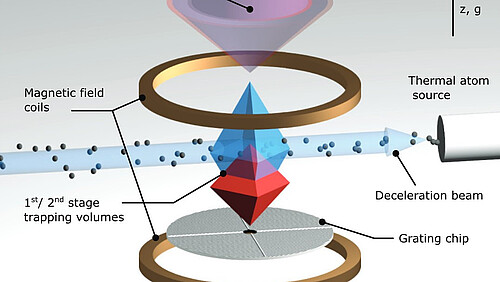Ion traps capture charged particles primarily through electric fields. Although a tailored laser beam cools the individual particles in ion traps, one beam is already sufficient. If in contrast, neutral atoms are the target, you have to rely entirely on the charge-independent optical force. Instead of one beam, a whole lattice of laser beams is then used, acting on the atom from all directions with specific wavelengths. Accordingly, such magneto-optical traps are often anything but compact or even scalable. Here, traps equipped with nanostructured chips in particular show great potential for miniaturization. The nanostructures in such grating magneto-optical traps (GMOT) split a single laser beam and thus make it used several times over.
Even though GMOTs generate the many laser beams compactly: the traps have so far only been able to diffract a single laser wavelength. Some atoms, however, require several, very different laser wavelengths. To address this problem, four researchers from the TU Braunschweig, the Physikalisch-Technische Bundesanstalt and the DLR Institute for Satellite Geodesy and Inertial Sensing joined forces at QuantumFrontiers. Together they designed and built a GMOT whose nanostructure enables the laser cooling of atoms with two different wavelengths in one trap.
This trap simplifies the handling of strontium atoms, for example. Their electrons have to jump around on several transitions between different energy levels for good cooling. What previously required different nanostructures is now united in a compact setup and enables more complex experiments and applications. With this technology, the researchers are thus driving the further miniaturization of quantum technologies that work with neutral atoms, such as optical atomic clocks.









